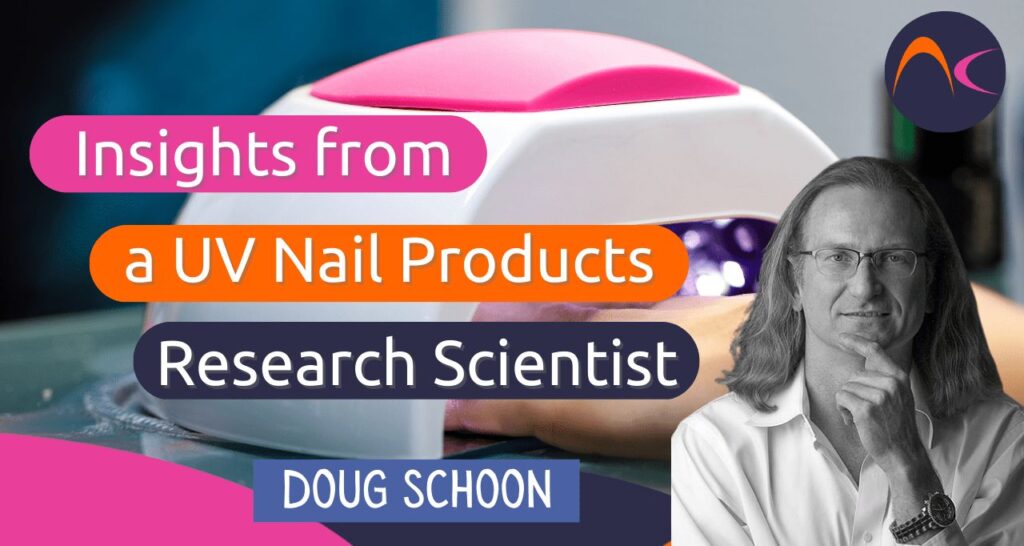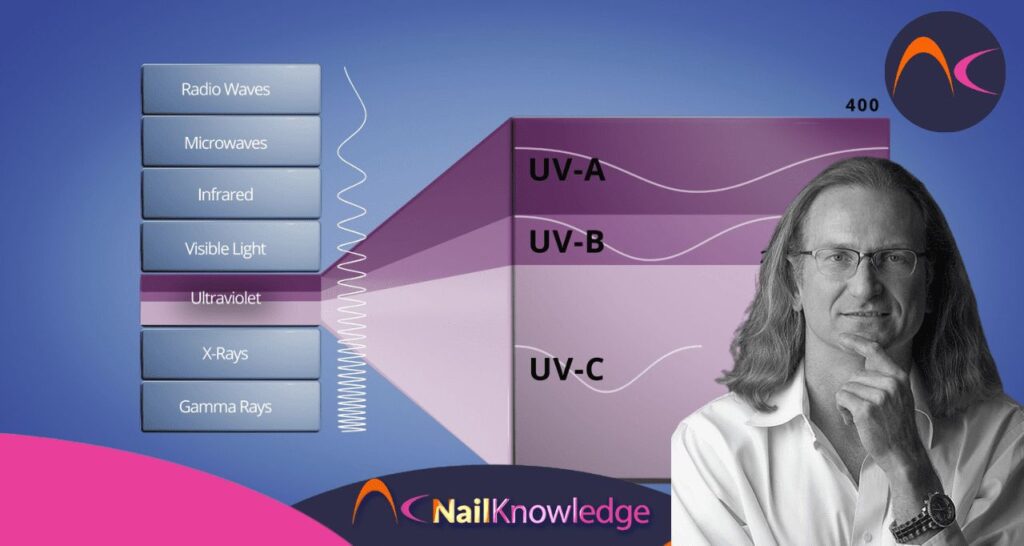No existe un sistema universal Lámpara UV para uñas that properly cures any UV nail product; nor are there UV curing nail products that properly cure with any nail lamp. Those who are making these erroneous claims are contributing to the growing number of consumers and professionals developing skin irritation and persistent or permanent alergias cutáneas que empeoran con el tiempo.
Información esencial para un servicio seguro de uñas curadas con UV
Fortunately, with the information and solutions presented in this article, these problems will be much easier to avoid which will allow nail professionals to protect themselves and clients while providing safe and beautiful UV cured enhancements and gel polish services.
Ideas de una investigadora de productos UV para uñas

As a research scientist, I have studied UV curing of nail products for more than 20 years and I’ve developed many UV curing nail products and UV nail lamps. I have also invented a unique scientific instrument designed to accurately test the curing of UV nail products under different UV nail lamps. I’ve performed testing on hundreds of different UV products using a wide variety of UV nail lamps containing either UV-emitting LEDs or CFLs (compact fluorescent tubes).
Contrary to what some believe, all nail lamps emit UV, even those that use LEDs. Exposure to UV is required for curing all types of UV products including UV cured enhancements and gel polish.
Estado actual de la investigación sobre productos y lámparas de curado UV
Mi investigación sobre estos productos y las lámparas de curado UV está en curso, por lo que la información facilitada en este artículo refleja la situación actual.
Conozca los riesgos de los productos UV para uñas poco curados
UV nail products can be under cured, over cured, or properly cured. The most common of these is under curing and it is a leading cause of irritación cutánea y alergia tanto a los clientes como a los profesionales de uñas cuando están expuestos a polvo/filamentos insuficientemente curados o mientras remojan los productos en removedor. Desafortunadamente, los profesionales de uñas y los clientes NO pueden determinar cuándo se produce un endurecimiento insuficiente con sólo mirar las uñas, ni pueden saberlo limándolas. Esto se debe a que los productos curados con UV se endurecen y pueden limarse cuando sólo están 50% curados. El producto se ve y se siente curado incluso cuando no se ha polimerizado (curado) a un nivel seguro.
After the client leaves the nail salon, the UV enhancement and/or gel polish may only cure an additional 4-6%, so when under curing happens these nail services will likely remain under cured even as it is worn over the next few weeks. Under curing creates lower durability which causes cracking, breaking, lifting and loss of shine. However, the greater problem is that under curing dramatically increases the risk of developing adverse skin reactions such as skin irritation or allergy in both nail professionals and clients.
Dust and filings from under cured UV products contain significant amounts of uncured ingredients such as monomers and oligomers or other substances. Over time repeated exposure to these uncured substances can cause adverse skin reactions or trigger existing skin problems. Typical symptoms are redness, itching, swelling, water blisters, onycholysis, numbness, unusual sensitivity to heat and pressure or, in extreme conditions, a total loss of the nail plate. Continued use causes the symptoms to progress and worsen.
Cuatro factores clave para el curado correcto de los productos UV

Curado adecuado minimiza estos problemas, por lo que es extremadamente importante. Hay cuatro factores importantes para determinar si un producto UV curará correctamente:
1. Gama de longitudes de onda UV emitidas por la lámpara de uñas
2. Intensidad de las longitudes de onda emitidas
3. Tiempo de exposición a los rayos UV
4. Thickness of the UV gel enhancement or polish
El papel de los fotoiniciadores en el endurecimiento UV de los productos para uñas
UV cured products contain specialized ingredients called photoinitiators without which proper curing would not be possible. Typically, photoinitiators are used between 1-5% concentration. There are many types of photoinitiators; most products contain only one type, but a few utilize two different types.
UV-A is the form of energy that energizes and activates photoinitiators to initiate curing. There are about 80 different possible wavelengths in the UV-A range, but only some of them are useful for curing. Wavelengths of UV are so tiny they are measured in nanometers (nm), which is one-billionth of a meter/yard. Photoinitiators used in UV nail products absorb UV-A between 320-400 nm, but not all the wavelengths emitted by LED nail lamps can energize each type of photoinitiator, typically only 10 of the 80 possible wavelengths can do so.
The activation range is highly unique to each photoinitiator- much like a fingerprint is unique to each person. Once energized the photoinitiator passes its absorbed energy to the monomers and oligomers which causes them to chemically join in long chains of polymers in a process known as curing or polymerization This curing cycle cannot occur unless the photoinitiator is exposed to the correct UV wavelengths. If these exact wavelengths are not emitted by the nail lamp, proper curing will not occur.
Factores que afectan al curado correcto de los productos UV para uñas
Las lámparas LED para uñas emiten una mayor intensidad de UV que las lámparas fluorescentes, pero en un rango mucho más estrecho. Esto puede afectar drásticamente a la capacidad de la lámpara para curar correctamente muchos productos UV. Por lo tanto, algunas lámparas LED para uñas no pueden curar correctamente formulaciones que contienen fotoiniciadores que requieren una gama de longitudes de onda diferente a la que emiten estas lámparas.
Another extremely important factor is the intensity of these wavelengths. If the intensity is too high, curing happens too quickly, creating excessive heat. Some warming is normal, however, overly rapid curing causes extreme heating during the first 30 seconds which can cause serious burns to the nail bed (the dermal layer beneath the nail plate) causing the nail plate to separate from the nail bed (onycholysis). When this occurs, nail bed infections become more likely.
Cuando la intensidad de las longitudes de onda UV es demasiado baja, se produce un endurecimiento insuficiente. Cuanto menor sea la intensidad de las longitudes de onda, mayor será el endurecimiento insuficiente, aumentando así el riesgo de reacciones cutáneas adversas. Un curado correcto requiere una lámpara UV para uñas que produzca la intensidad adecuada de las longitudes de onda necesarias según el tipo y la concentración del fotoiniciador o fotoiniciadores de la formulación.
Importancia de un intervalo de tiempo adecuado para el curado UV
Another critical factor is the length of time the UV product is under the lamp. During my many years of testing I have never found a UV cured product that properly cures with 30 seconds (or less) exposure for each layer- yet I have repeatedly seen this erroneous marketing claim. Don’t be fooled- this isn’t proper curing- it is merely hardening which occurs with 50% cure.
Mi investigación indica que el curado adecuado no puede producirse con menos de 60 segundos por capa bajo la lámpara de uñas correcta para el producto de curado UV específico. Añadir cantidades excesivas de fotoiniciador no ayuda. Por el contrario, tales productos se sobrecalentarán fácilmente y causarán dolorosas quemaduras en el lecho ungueal y onicólisis.
La técnica del curado flash
Testing indicates a useful technique to prevent overheating is to pull the fingernails from the nail lamp for a few seconds and then reinsert them (commonly referred to as flash curing), however, it is important to ensure each layer receives the full curing time stated in the product’s directions.
Contrariamente a lo que algunos creen, un producto UV para uñas correctamente formulado no sobre cura if the nails are left under the nail lamp for a minute or two longer than directed. Also, completing a full cure after ”flash curing” will not result in an over cured product. Additionally, it is important to understand that if a nail lamp does not emit the correct wavelengths at the correct intensity, leaving nails under the lamp for a longer time will not help to achieve a higher degree of polymerization.
Importancia del grosor de la capa para el correcto endurecimiento UV de los productos para uñas
El grosor de las capas aplicadas también es muy importante. Cuanto más gruesa sea la capa aplicada, más difícil será conseguir un curado adecuado, ya que las capas superiores absorberán la mayor parte de los UV, dejando las capas inferiores sin curar. Dos capas más finas curarán mucho mejor que una capa gruesa, siempre que cada capa se exponga a la intensidad correcta de las longitudes de onda UV correctas durante el tiempo indicado en las instrucciones del producto.
Como se ha indicado anteriormente, mis investigaciones indican que el tiempo mínimo de curado debe ser de al menos 60 segundos por capa para garantizar unos niveles de polimerización suficientemente seguros.
Por qué el vataje no es un indicador fiable de la intensidad UV en las lámparas LED para uñas
Some will be surprised to learn that the wattage of an LED nail lamp does NOT indicate the UV intensity. Wattage is the amount of electrical power used by the lamp, not its UV intensity (also known as irradiance). UV intensity is the amount of UV energy that hits a surface. Wattage can be used to estimate the total intensity of light emitted but includes the intensity of both visible and UV light, so it is not an accurate measurement of a nail lamp’s UV intensity.
It is not wise to purchase a UV lamp based solely on the listed wattage. This common misunderstanding may lead the unwary into purchasing an unsuitable nail lamp that may not properly cure the products in use. Nail lamps’ UV intensity in milliwatts should be measured specifically at 400, 390 and 380 nm. This provides a more accurate measure for UV intensity and more meaningful/useful information.
Necesidad de normas para el etiquetado de lámparas UV para uñas y productos de curado UV
The obvious solution to avoid under/over curing would be for UV nail lamp manufacturers to indicate on the label the UV watts intensity at 400, 390 and 380nm.
Además, los fabricantes de productos de curado UV deben proporcionar los milivatios de 400, 390 y 380 nm necesarios, así como el tiempo mínimo de exposición necesario para curar correctamente sus fórmulas. Con esta información, los usuarios pueden asegurarse de que están utilizando las lámparas LED para uñas correctas para garantizar el curado adecuado de mejoras UV o esmaltes de gel específicos.
Desafortunadamente, esta información tan necesaria no se proporciona actualmente. Espero que, en el futuro, todos los fabricantes/distribuidores proporcionen esta importante información para que los profesionales de la manicura puedan determinar qué lámpara(s) curará(n) adecuadamente los esmaltes en gel o las mejoras curadas por UV de su elección.

